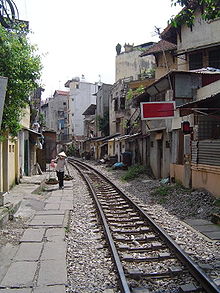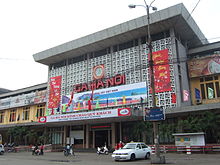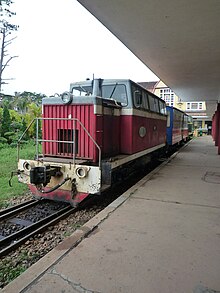 | |
| Native name | Tổng Công Ty Đường Sắt Việt Nam |
|---|---|
| Company type | State-owned enterprise |
| Industry | Rail transport |
| Headquarters | Hanoi, Vietnam |
| Website | dsvn |











Vietnam Railways (VNR, Vietnamese: Đường sắt Việt Nam) is the state-owned operator of the railway system in Vietnam. The principal route is the 1,727 km (1,100 mi) single-track North–South Railway line, running between Hanoi and Ho Chi Minh City. This was built at the metre gauge in the 1880s during the French colonial rule. There are also standard gauge lines running from Hanoi to the People’s Republic of China, eventually leading to Beijing, and some mixed gauge in and around Hanoi.
Problems
| This section does not cite any sources. Please help improve this section by adding citations to reliable sources. Unsourced material may be challenged and removed. (May 2021) (Learn how and when to remove this message) |
While the state of the country’s road network is consistently improving, the railway system makes a significant contribution to the national transport infrastructure, with multiple daily freight trains, many being movement of containers. The 29-34-hour passenger trip between Hanoi and Ho Chi Minh City is very popular both with locals and foreign visitors. Accommodations are: hard seat, soft seat, 4 berth sleeper, and 6 berth sleeper. Coastal resorts such as Huế, Hội An, and Nha Trang lie along the route and generate considerable tourist traffic. There are no travel restraints in place, and tickets for most trains can be purchased on-line. In the border region, the Sapa line to the north is a very popular tourist attraction, with first class accommodations available. East of Hanoi, the line is dual gauge, with through trains to China available. Visas are required to book cross-border trains. The Ho Chi Minh City–Hanoi line has been rebuilt and upgraded, and damage from war has been repaired.
Projects
There is a long-term plan to build a completely new standard-gauge line to connect the two main cities. New international routes to Phnom Penh and thus via Bangkok to Singapore are also under consideration. A parliamentary resolution of 2005 proposed that foreign investors be invited to invest in Vietnam Railways. On September 11, 2008, the Cambodian Ministry of Transportation announced a new railway line with the total length of 257 km (160 miles) will connect Phnom Penh with Loc Ninh (Binh Phuoc province), Vietnam. This US$550 million project has been carefully investigated by Chinese experts and is about to be carried out in the near future. Vietnam is extending its network to Loc Ninh. In August 2010, the government announced plans to build two sections of standard-gauge railway, one from Hanoi to Vinh and the other from Ho Chi Minh City to Nha Trang.
Although on the face of things the possibility of a good return might appear small, there are precedents: the lines into China have benefited from Chinese investment and, more recently, Japanese investment was spent on the Hai Van Tunnel project, a new road tunnel alongside the north-south rail line near Da Nang.
At a more local level, the picturesque hill town and resort of Đà Lạt was once connected by a scenic little rack railway to the main north-south line at Thap Cham. Although there is now little visible trace of the trackbed in the green and fertile landscape, local businesses have secured a promise of government funding for its reinstatement, to benefit tourism in the area. Currently, the only railway at Đà Lạt is an 8 km (5 miles) remnant from the old railway connection that runs from Đà Lạt station to the nearby village of Trại Mát. This is run as a tourist attraction.
Other projects likely to receive foreign money are proposed light rail systems within Hanoi.
Connection with Laos
A project to connect the Vietnamese Railway system with Laos in currently underway. The Laos-Vietnam railway system, connecting Thakhek District in Khammouane Province, Laos, to the Laos-Vietnam border, is expected to open for public use in 2028. The new railway will enhance Laos’ socio-economic development and become a reliable source of revenue for the Lao Government's long-term budget. The railway system will also enhance Laos' connectivity as a transport and trade hub within and outside the Southeast Asia (Asean).
High-speed rail plans on hold
Further information: North–South express railway (Vietnam)Vietnam Railways also planned a 1,630 km (1,013 mi) high-speed standard gauge link from its capital Hanoi in the north to Ho Chi Minh City in the south, capable of running at 250 to 300 km/h (155 to 186 mph). It was planned to have an initial travel time of 9 hours and to make a series of improvements over time to eventually reduce the time to 5 hours. The current single track line has journey times from just under thirty hours.
The funding of the $33 billion line was to come mostly from the Vietnamese government, with the help of Japanese aid (on the understanding that Japanese firms would engineer the bulk of the project). In 2010, there was an unsuccessful push to fund the project, and efforts to promote the project have fallen off since then.
The timetable called for the initial construction (the 9-hour line) to be completed in 2016, and the line improvements (the 5-hour line) by 2025. At one point, the Vietnamese prime minister had set a target to complete the line by 2013. Approval was delayed several times, and in May 2010, the plan was finally rejected by the government.
Locomotives
| # | Type | Units | Power |
|---|---|---|---|
| 1 | D8E | 2 |
871 horsepower (650 kW) |
| 2 | D12E | 40 | 987 horsepower (736 kW) |
| 3 | D18E | 16 | 1,800 horsepower (1,300 kW) |
| 4 | D11H | 23 | 1,100 horsepower (820 kW) |
| 5 | CKD7F/D19E | 80 | 1,950 horsepower (1,450 kW) |
| 6 | GE-U8B/D9E | 33 | 900 horsepower (670 kW) |
| 7 | GE-U8B/D10E | 22 | 1,000 horsepower (750 kW) |
| 8 | YMD4/D13E | 22 | 1,300 horsepower (970 kW) |
| 9 | D5H | 13 | 500 horsepower (370 kW) |
| 10 | D10H | 20 | 1,000 horsepower (750 kW) |
| 12 | D4H | 77 | 400 horsepower (300 kW) |
| 13 | SDD3/D19Er | 5 | 1,950 horsepower (1,450 kW) |
| 14 | D14E | 5 | 1,400 horsepower (1,000 kW) |
| 15 | SIEMENS Asiarunner AR15VR/D20E | 16 | 2,011 horsepower (1,500 kW) |
Overview
Routes
- North-South
- Local
- Hanoi-Beijing
Lines
- Hanoi-Saigon Railway
- Hanoi-Lao Cai Railway
- Hanoi-Quan Trieu Railway
- Hanoi-Dong Dang Railway
- Hanoi-Haiphong Railway
- Kep-Ha Long Railway
Stations
- Saigon station
- Ninh Hòa station
- Nha Trang station
- Diêu Trì station
- Quảng Ngãi station
- Đà Nẵng station
- Huế station
- Đồng Hới station
- Vinh station
- Hải Phòng station
- Hanoi station
- Đồng Đăng station
- Lào Cai station
- Biên Hòa station
- Bồng Sơn station
- Đức Phổ station
- Núi Thành station
- Tam Kỳ station
- Trà Kiệu station
- Tháp Chàm station
- Phan Thiết station
Gauges
- 1,000 mm (3 ft 3+3⁄8 in) (2,169 km (1,348 mi))
- 1,435 mm (4 ft 8+1⁄2 in) (standard gauge, 178 km (111 mi))
- 1,435 mm (4 ft 8+1⁄2 in) and 1,000 mm (3 ft 3+3⁄8 in) (dual gauge, 253 km (157 mi))
Trackage
- Total 3,160 km (1,960 mi)
- 506 km (314 mi) of siding
Rolling stock
- 331 diesel locomotives
- 34 steam locomotives
- 852 coaches
- 3922 cars
Hotels
- Hai Can Nam Hotel
- Saigon Railway Hotel
- Kham Thien Hotel
- Mat Son Hotel
- Sam Son Hotel
- Ha Thanh Hotel
- Le Ninh Hotel
- Nha Trang Railway Hotel
- Ca Na Railway Hotel
- Da Lat Railway Hotel
- Ky Dong Hotel
- Hai Van Bac Hotel
- Mua Xuan Hotel
See also
|
General information
Notable rolling stock
Notable Vietnamese rolling stock manufacturers |
Rapid transit projects in Vietnam
|
Notes
- ^ "2010-10-01". Retrieved 2010-10-12.
- "A Brief History of Dalat Railroad". Viet Nam Air Force Model Aircraft of Minnesota. 2007-10-07. Archived from the original on June 14, 2006. Retrieved 2008-03-14.
- "1928 Thap Cham-Da Lat Railway returns". Vietnamnet, from official Viet Nam News agency. 2007-10-07. Archived from the original on 2008-02-10. Retrieved 2008-03-14.
- "Laos-Vietnam railway expected to open for use in 2028". Railpage. Retrieved 12 September 2023.
- "Railway plans to build 880 km express line". Viet Nam News. 2006-07-20. Retrieved 2006-07-20.
- "Vietnam Railways Website (English) - Check the timetable from Ha Noi to Sai Gon (or vice versa) to see the journey times". Vietnam Railways. Archived from the original on 2008-05-10. Retrieved 2008-05-10.
- "Vietnam to build high-speed rail with Japan aid". 2006-07-20. Retrieved 2006-07-20.
- Bill Hayton (2006-07-20). "Vietnam plans new railway link". BBC News. Retrieved 2006-07-20.